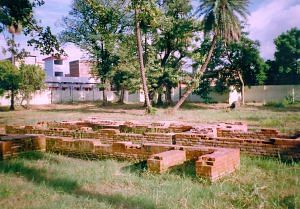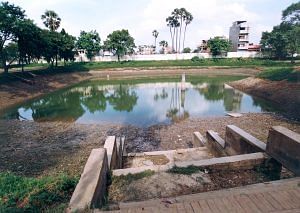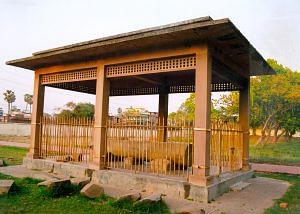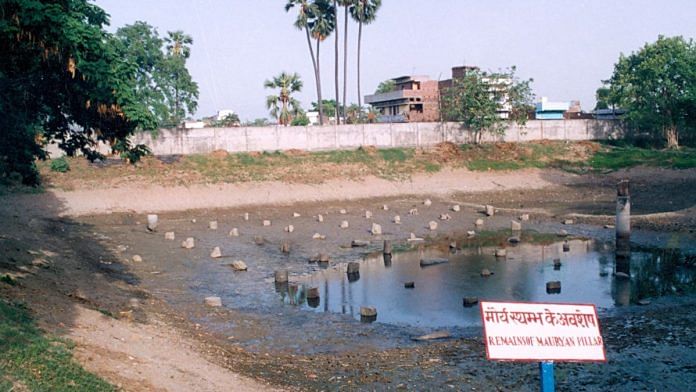For centuries, the exact location and extent of the ancient city of Pataliputra remained a subject of debate. City after city was built on top of its ruins, but no one could pinpoint where it was. Even though Chinese travellers like Fa Hien heavily documented Pataliputra in their topographical records, it took a careful survey and multiple excavations to verify the gilded details mentioned in these texts.
Decades of scholarly research and exploration led to the unearthing of the ancient Magadhan capital near modern-day Patna. Today, these ruins recounted by Chinese scholar and traveller Hiuen Tsang are buried beneath the modern city of Patna, much of them lost to contemporary urbanisation. Ironically enough, the ancient city epitomised urban development in the 3rd century BCE. All that is left of the powerful metropolis are chronicles glorifying its history and narratives recording past excavations.
Old records and excavations are usually overlooked, but in the case of Pataliputra, they are goldmines of data – especially considering the threat of urbanisation and its potential to stall future digs.
Origins of Pataliputra
Pataliputra was the second capital of the Magadhan Empire, the foundations of which were laid during the reign of Ajatashatru, a contemporary of Buddha who belonged to the Haryanka Dynasty (c. 4th -5th BCE).
Ajatshatru transformed a small village called Paligrama into a city by fortifying it. However, it was his son and successor, Udayin, who made it what it was by relocating the seat of Magdadhan power from Rajgriha to Pataliputra. This shift in capital boosted trade and commerce along the Ganga and enhanced access to key routes, making the city a thriving economic and cultural hub synonymous with excellence.
Pataliputra prompted Chinese travellers like Hiuen Tsang to pause and recount its illustrious past. An honest account of the city was written roughly 2,000 years ago, in c.300-302 BCE, by Megasthenes, a Greek ambassador at the court of Chandragupta Maurya. He described it as a nine-mile-long city planned in a parallelogram, protected by large timber walls guarded by 64 gates and 570 towers and apertures for launching arrows, with a moat beyond. It was home to around 400,000 people.
Also read: How the 2008 Alamgirpur re-excavation challenged timeline of mighty Harappan Civilisation
Digging for Pataliputra
In his 1788 work Memoir of a Map of Hindoostan – or the Mogul Empire, British geographer Major James Rennell was the first to conclusively establish a connection between Modern-day Patna and the two ancient cities of Palibothra and Pataliputra, mentioned in Greek and Sanskrit sources, respectively. This aided Scottish surveyor Francis Buchanan, who was the first to conduct regular surveys in Patna. Early explorers like Alexander Cunningham and JD Beglar also repeatedly attempted to find the locations Huien Tsang and Fa Hien mentioned in their chronicles. These surveys prepared the ground for the first excavation in Patna by LA Waddell between 1892 and 1899.
However, the most noteworthy discovery of Waddell’s dig was the palisade, which he compares to the one he discovered in the Swat Valley in 1893. He was aware that 30 years before his excavations, 25-30 beams had been uncovered when constructing a tank at ‘Maharajkhanda’ or ‘The Emperor’s Moat’, and he later recognised them as the wooden towers referenced by Megasthenes. While following this track in Bulandibagh, Tulsimandi, and Maharajganj, he uncovered upright remains of beams made from sal wood. The beams, which were 18-20 inches in diameter, appeared to be placed in a double line approximately 5.5 feet apart, and each post appeared to be joined by a transverse plank. The gap between the two rows of beams was most likely filled with earth.
Waddell’s discovery of an Ashokan pillar, the location of the huge stupa and other sculptural remnants, along with the excavated ruins, provided strong evidence identifying Kumrahar village as the site of the ancient palace at Pataliputra. Waddell also proposed that the palace would have spanned from Chhoti-Pahari to Kumrahar.

Scholars continue to uphold Waddell’s work as a benchmark in their field. Other academics like PC Mukherjee also explored Lohanipur near Patna in 1897-98 at the same time as Waddell and discovered a 76-metre-long trench that went from east to west. However, it was the 1912 excavation led by archaeologist DB Spooner—one of the first to be privately funded—that brought to light unknown facets and questions of the ancient city.
Also read: Did you know that India has a 7200-year-old history with cotton? Harappans took it to the world
DB Spooner explores a Persian connect
On 9 November 1914, a paragraph titled Parsee Dominion in India was published in the London correspondent section of the Times of India. It detailed the excavation at Pataliputra between 1912-17, led by Spooner and approved by Sir John Marshall of the Archaeological Survey of India. It seemed to hint at a heavy influence of Persipolition architecture on Indian architectural styles and indicated Ancient Iranian domination in eastern regions beyond Punjab. Spooner subsequently mirrored these sentiments in a paper titled The Zoroastrian Period of Indian History, published in the Journal of Asiatic Society of England (1915).
Re-excavation at Bulandibagh and Kumrahar and additional dig finds compelled the investigator to put forth such assertions. Piles of stone fragments in a straight line placed at a regular interval of 4.57m, i.e., 15 ft from each other, was one of the major discoveries of this excavation. These remnants consisted of sandstone pillar fragments, with Spooner successfully excavating a total of 80 such pieces (72 of which were found on the site). His deduction pointed to these being the vestiges of a Mauryan pillared hall. The hall, which had an area of 39.14m x 31.66m, appears to have constituted an open pavilion and was perhaps reached by boat through a canal.

The excavation highlighted the question of architectural origins in India. John Marshall, the Director-General of the ASI from 1902 to 1928, pointed out that the remains of the pillared hall are the oldest structures in India, except for the Mauryan Chaitya hall found at Sanchi in Madhya Pradesh. (Annual Reports of the Archaeological Survey of India Eastern Circle 1912-23: 56).
The original Mauryan floor was discovered beneath a layer of pillared fragments, and no upright shafts or pedestals were found resting on it. Above these pillar fragments were heaps of ashes and charcoal about a foot deep, followed by the remains of a brick wall dating from the Gupta and post-Gupta periods. Spooner proposed that the building’s timber superstructure was destroyed by fire in the 5th century CE, before the construction of the brick edifice. The columns were characterised as monoliths built of Chunar sandstone that stood free on the timber floor without socket holes.

He first believed that the pillars were erected without a pedestal; however, this was eventually changed to conform to the Persepolitan layout. Based on the existence of distinct black circles in the silt deposit and their specific dimensions, he speculated that statues on pedestals must have stood between columns. He saw a likeness between the Pillared Hall and the House of Xerxes.
This dig brought to light what was significantly missing in Waddell’s excavation. The remains of a palatial building or an administrative structure could corroborate the literary testimonies through archaeological remains, but Spooner’s judgement of the pillared hall was never steady.
Spooner was aware that more digs were needed to back up his assertions. However, he was confident in his Persian connection theory. With considerable support from Ratanji Jamsetji Tata, who was particularly interested in discovering his ancestry, Spooner felt compelled to develop a foreign influence in Indian art and architecture, which was reflected in his methods (Bishnupriya Basak). Spooner was adamant about establishing Zoroastrian-Parsi ancestry to the Mauryan emperors, even going so far as to declare the Mauryan ruler Chandragupta Maurya a Parsi [PC Mukherjee 1898. Report on the Excavations on the Ancient Site of Pataliputra (Patna-Bankipur)]. Due to the absence of a comparable parallel in India, he advocated a resemblance between Persepolis’ Achaemenid Hall and the Mauryan Hall. Some archaeologists, like A Ghosh, argue that this pillared hall was the assembly hall of Ashoka’s third Buddhist council rather than the Durbar Hall of Chandragupta Maurya.
Thirty-eight years after Spooner’s dig, AS Altekar and Vijayakanta Mishra’s excavation confirmed the existence of a pillared hall. Instead of Mauryan or the succeeding period’s administrative structures, they dug many monastic complexes. No flood deposit was found by them either. They were, in fact, opposed to Spooner’s sinkage hypothesis. According to their findings, the ashy tubes were not created by pillar sinkage but might have been caused by subsequent disruption caused by stone thieves. They also discovered Sunga and Kushana structures beneath the Gupta period brick wall structure in the Pillared-Hall area.
This excavation conducted by Altekar and Mishra marked a significant step toward understanding the dynastic periods in ancient Indian history by establishing cultural evolution at the site
Also read: Did Harappans exploit animals for dairy? Lipid residue from Gujarat’s Kotada Bhadli has answers
Chhoti Pahari and Panch Pahari
Apart from the Pillared Hall and palaces that Spooner so eagerly explored, Chinese texts mention stupas at places like Chhoti Pahari and Panch Pahari in Bihar
The great stupa at Chhoti Pahari is regarded as the spot where Buddha rested. Pilgrim records state that the stepping stone of Buddha existed here – like the one at Bulandi, a temple, a great edict pillar recording Ashoka’s great gift to Buddhism, and the Chaitya Hall. This stupa was regarded as the first of 84,000 stupas erected by Ashoka and contained Buddha relics bordering the palace. Hieun Tsang also noted that the stupa was in ruins, with its foundation walls sunk. Moreover, the bricks were plundered by residents much before Waddell’s excavation, and they could only find traces of what would have been a magnificent tomb.
Where are these remains now?
The name Chhoti Pahari is still in existence, and the site is also considered a protected monument, but not much is left of the great Stupa of Chhoti Pahari. The case of Panch Pahari, which is south of Chhoti Pahari, is similar, where five stupas were said to be surrounded by several tens of stone dwellings.
Now, where is the rest of Pataliputra? I am sure that you would have understood that not one but multiple excavation attempts spanning decades have gone into reconstructing the story of an ancient society.
And I worry that these 40 years of research are all we will have for future reference.
Disha Ahluwalia is an archaeologist and junior research fellow at the Indian Council Of Historical Research. She tweets @ahluwaliadisha. Views are personal.
(Edited by Zoya Bhatti)



